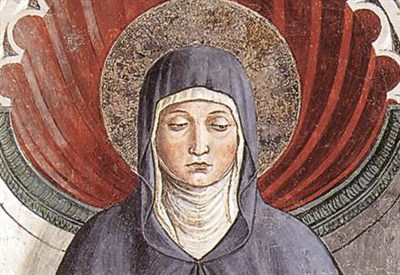PRAYER TO SANTA MONICA to ask for a grace
Wife and mother of unspeakable evangelical virtues, to whom the Good God has given grace, through his unshakeable faith in front of every tribulation and his constant confident prayer, to see her husband Patrizio and his son Augustine converted, accompany and guide us, brides and mothers on our arduous journey towards holiness. Santa Monica, you who have reached the peaks of the Most High, from above watch and intercede for us who reel in the dust between a thousand and a thousand difficulties. We entrust our children to you, make them a beautiful copy of your Augustine and give us the joy of living with them moments of intense spirituality such as you lived in Ostia, to be together where you are. Collect all our tears, water the wood of the Cross of our Jesus so that abundant heavenly and eternal graces may flow from it! Santa Monica pray and intercede for all of us. Amen!
Monica was born in 331 in Tagaste, the ancient city of Numidia, today Souk-Ahras (Algeria), into a deeply Christian family of good economic conditions. She was allowed to study and took advantage of it to read the Bible and meditate on it.
Married to Patrizio, a modest owner of Tagaste, not yet baptized, whose character was not good, and who was often unfaithful, with his mild and sweet character he could overcome the harshness.
He gave birth to his first-born son Agostino in 354. He had another son, Naviglio, and a daughter whose name is unknown. He gave all three a Christian education.
In 371 Patrick converted to Christianity and was baptized; he will die the following year. Monica was 39 and had to take over the management of the house and the administration of the assets. He suffered greatly from Augustine's loose conduct. When he moved to Rome, he decided to follow him, but he, with a stratagem, left her on the ground in Carthage, while embarking for Rome.
That night Monica spent it in tears on the tomb of St. Cyprian; although she was deceived, she did not give up and heroically continued her work for the conversion of her son.
In 385 she also embarked and joined him in Milan, where in the meantime Agostino, disgusted by the contradictory action of the Manicheans in Rome, had moved to cover the chair of rhetoric.
Here Monica had the consolation of seeing him attend the school of S. Ambrogio, bishop of Milan and then prepare for baptism with the whole family, including his brother Navigio and friend Alipio; therefore his prayers had been answered. The bishop of Tagaste had said to her: "It is impossible for a child of many tears to be lost."
Monica remained at the side of her son advising him in his doubts and finally, on Easter night, April 25, 387, he was able to see him baptized together with all the family members. By now a deeply convinced Christian, Augustine could not remain in the existing marital situation. According to Roman law, he could not marry his cohabiting handmaid, because of a lower class, and in the end, with the advice of Monica, now elderly and eager for the accommodation of her son, it was decided to postpone, with her consent, the 'handmaid in Africa, while Agostino allegedly provided for her and her son Adeodato, who stayed with him in Milan.
At this point Monica thought she could find a Christian bride suited to the role, but Agostino, to his great and welcome surprise, decided not to marry anymore, but to return to Africa too to live a monastic life, indeed founding a monastery.
We find her next to her son in Cassiciaco, near Milan, discussing with him and other family members about philosophy and spiritual things, and knowingly participating in the speeches, to the point that Augustine wanted to transcribe his mother's words in his writings. This sounded unusual, because at the time women were not allowed to speak.
With Agostino he left Milan for Rome, and then for Ostia, where they rented a house, waiting for a ship leaving for Africa. It was a period full of spiritual dialogues, which Augustine brings us back to his Confessions.
There he fell ill, possibly with malaria, and died, in nine days, on August 27, 387 at the age of 56. His body was buried in the church of Sant'Aurea di Ostia.
On April 9, 1430 his relics were moved to Rome in the church of S. Trifone, today of S. Agostino, and placed in a precious sarcophagus, the work of Isaiah of Pisa (XV century).
The Catholic Church celebrates its memory on August 27 (previously it was celebrated on May 4), the day before that of St. Augustine, who, coincidentally, died on August 28.
